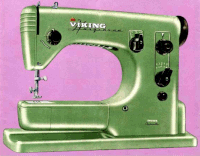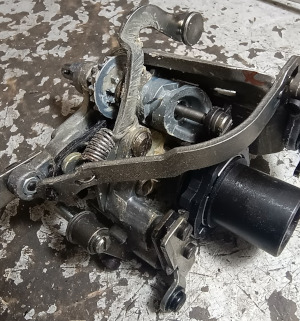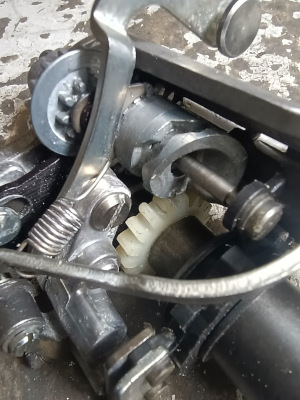

Please note that this page is a work in progress. I will update with more details and photos but thought that I would get the information out there as soon as possible in order to help the hopeful DIYer.
The fact that I love repairing Husqvarnas means I will repair them. As mentioned, technicians avoid these due to the work involved. In the past I haven't performed a full restoration of a seized and broken 2000 from “unused for decades” condition for someone else. This changed when a lady came into the shop one Thursday afternoon (20/7/23) with a 6460 that hadn't been used for a very long time. It was completely seized, the reverse was stuck, the camstack was broken, the buttonhole function seized, the motor brushes worn out but it looked in excellent condition otherwise. I started prior to 6am on a Friday morning (probably at 5:50) and finished the test sew at 2:05pm, having taken a total of about 15 minutes for breaks (customers picking up and dropping machines off). That's *eight hours of work* by someone who has a lot of experience with these, and there wasn't anything unusually troublesome about it.
So the lesson is that even for an experienced repairer, it takes a very long time to fix one of these. All of these problems are caused by Husqvarna's use of sintered bearings. Several years of being idle causes the leaking lubricant to settle on the bearings and completely dry out, effectively gluing the bearings. The good news is that by now none of the built-in lube is left, so it will never happen again (unless you ‘lubricate’ with something like WD-40 or 3-in-1 oil, which also dry out and leave a sticky residue).
If the pattern mechanism is seized, there's a high chance that the stitch width will be very tight and you can't get it into or out of buttonhole mode (with the dial on zero width you pull the dial and it should click). This leads me to the non-aligned buttonhole issue. Get yourself a bottle of methylated spirits and put a spray top on it. Be very careful not to get it onto the exterior, as it will melt the paint I usually put a cloth around what I'm attempting to free up to absorb the excess. Spray some onto the part between the plastic and metal parts and turn the dial. It will quickly become easier and in just a few minutes it should be quite easy to turn. Now put it on zero width and look at the mechanism. There should be a U shaped male part that fits into a U shaped female part. If these are not there, the metal part (towards the front of the machine) has slipped around and must now be turned until it allows the other part to enter when the dial is pulled for buttonhole mode. Be extremely gentle here. Remember that most of the metal on a seized Husqvarna had lubricant embedded. This means that the metal is not solid and can be more easily damaged, marked or broken. Putting a mark on the metal is something you will feel later when you go to use the machine. You'll be kicking yourself for not being careful enough. If you have to use a big screwdriver, wrap cotton around it. The metal part is curved and friction will still allow it to be moved. If you're lucky, your machine now has a working stitch width and buttonhole mechanism. Now you can put it into buttonhole position 2 and continue. I have only needed to actually remove the stitch width mechanism on a couple of occasions, which is just as well: It is very time consuming.
Never attempt to force the dial, or you will break the pattern indicator gear.
After much trial and error, I discovered that it is entirely possible as well as a good idea to remove the whole pattern mechanism as a single unit. Take plenty of photos if you want to do this, and before starting download the technical briefing (service manual). If you do this job often, you should get to the point of being able to remove in under five minutes.

If you haven't already, put it in buttonhole stage 2 (bar tack), which makes it much easier to disconnect everything for removal of the pattern mechanism. There are three points to disconnect prior to removal of the pattern mechanism: The fork-shaped metal connection at the front of the stitch width mechanism, which controls the needle position - use a flat screwdriver to pry it away from the pattern mechanism then push it to the left until it stays out of the way. The two part spring loaded connector that goes from the back of the stitch width mechanism to the top and is secured with a circlip (careful with that circlip) - disconnect it. Remove the light fitting (there is a single flat screw visible when you pull the cover down), replace the screw in the light fitting so you don't lose it. Remove the white cover (I do this with the machine needle), then the screw holding the front dial. Finally, the big screw at the back. You don't need to remove the camstack separately.

Manipulate the zig-zag lever (just to the right of the camstack) so it isn't in the way - I usually push it to the right then back so it's free of the mechanism. Use the tilted part that the light fitting screws into to assist here, and put the light fitting cord over this (the light fitting will stay in the machine) and once it's free you should be able to move the whole mechanism backwards. There is a spring surrounding the light wiring and it needs to be unhooked from the pattern mechanism. After this, the pattern mechanism will come straight out of the machine as a unit. Be aware that the automatic feed actuator (the leftmost part of the pattern unit) can fall when you remove the unit. Once the unit is out, you should carefully disassemble it and clean the wax from every part. It's very important that you don't force anything, the gears can break quite easily.
If you need to buy a new camstack (originals are almost always cracked), I don't sell them but Walter's import does. They aren't cheap, but these machines will never be made again.
After removal, the mechanism must be disassembled. To do this, carefully follow the instructions in the technical briefing (service manual). I will add detailed instructions and photos to this page later. Until then, make sure you can get it back together without these. I usually pop the parts into a jar with methylated spirits and mineral turpentine. This will soften the lubricant and make it very easy to remove. Wear gloves so you don't get it on your hands. Disassemble so that all gears are removed from each other as well as from the pattern mechanism frame as per the technical briefing. If parts are very stuck, do not force them. Heat from a heat gun or hair dryer will soften the dried lubricant and make it much easier. Forcing any of the gears will break them. You should also remove the pin that the plastic knob fits onto, using pliers. Do this carefully so you can re-use it. Clean all parts and put it back together again. Be aware that I'm only focussing on putting back the gears so that you align them correctly, but you need to put other parts back on before the gears. The technical briefing shows you the order of the other. As you put it back together, the left needle zig-zag pattern will be selected (turn the outer knob clockwise), the inner knob has an alignment mark on one of the gear teeth. Grease lightly (I use Inox teflon grease) and put back the gear that this meshes with and align both gear's marks. Now put back the gear that moves the pattern cam. Grease this too. Getting this back on is a bit tricky because you have to hold the two parts while putting the gear on. The position is at the lowest possible point. There is a timing mark, but sometimes it's not obvious. Once this is on, put the screw in that holds all the gears on. Make sure that one side of it is not hitting anything. Once the gears are all on, put the horizontal bar and spring (that goes across the mechanism) back on then the dial and the knob and turn it to make sure you can select all of the patterns. You will need to hold the small black metal part up or it will get stuck. If you can't select all patterns you haven't aligned the gears correctly. If you have, replace the driving gear and camstack. Before you do, free up the metal gear that drives the pattern mechanism. This will be seized, and must be un-seized to set the zig-zag swing timing. It is immensely easier to do it while the pattern mechanism is out of the machine. Take out the two grub screws, squirt some methylated spirits into the holes and pop a small metal bar into the hole. Remove the plastic hand wheel (you can break it by using force) and use vise grips to hold the main shaft instead. Move it as gently as possible. It doesn't take much time to get the chemical in there. Once it's freed up, push the gear to the left and clean where it was. Put it back in place against the little black stop and put the grub screws back in. Don't forget the automatic width controller on the left or to put the light spring back on (this needs to be done as you're inserting the mechanism. The light fitting should be wrapped above the support bar to rest at the front. Put the pattern mechanism back in and re-attach the three points of contact. Put the screw back in (with the plastic and metal washers) and put the indicator dial and knob on the front.
The reverse on this is almost always seized, so that's what we'll deal with. The problem is caused by dried lubricant inside the part that toggles, so we must free this up. This also take the greatest amount of time of all the seized parts.
You will need to put some force on this part, but because it's weak, you will need to minimise the possibility of damage. I have a very large flat blade screwdriver whose width is almost exactly the same as the gap from top to bottom of the toggle, so get your most appropriately sized screwdriver. You will also need either a heat gun or a hairdryer. This is to warm up the part, making the dried lubricant much easier to get rid of. You will also need a jar of the chemicals mentioned before (methylated spirits + mineral turpentine) and a toothbrush. Heat the area that's seized but don't overdo it. I heat them for about 10 seconds with my heat gun on the low setting. Once the area is warm, scrub it with the chemicals then try and move the toggle. It might take a fair force to get it moving but if it's warm it should move. Scrub again. When it cools, warm it up again and repeat. The worst machines I have dealt with so far have been 6440s, where it has taken more than an hour to remove the lubricant. Expect that it will take you at least this long. It should be getting easier with each round of heating and chemical scrubbing. You will get to the point of it being very easy to move the toggle, at which time you can stop heating it. Now you can switch to moving the feed backwards with the reverse button and forwards by pushing the feed dog directly, until there is absolutely no resistance. If there is any at all, and you think it's good enough, stop for an hour (until it cools down) and go back to it and it will probably be seized again. Once there is no resitance, you can blow it out with a compressor hose (if you have one) or just wait until it dries. Once it's dried and cold, push the reverse and make sure it is still good.
Address: 392 Burwood Road, Hawthorn, Victoria, Australia
Phone: 0412 341 948